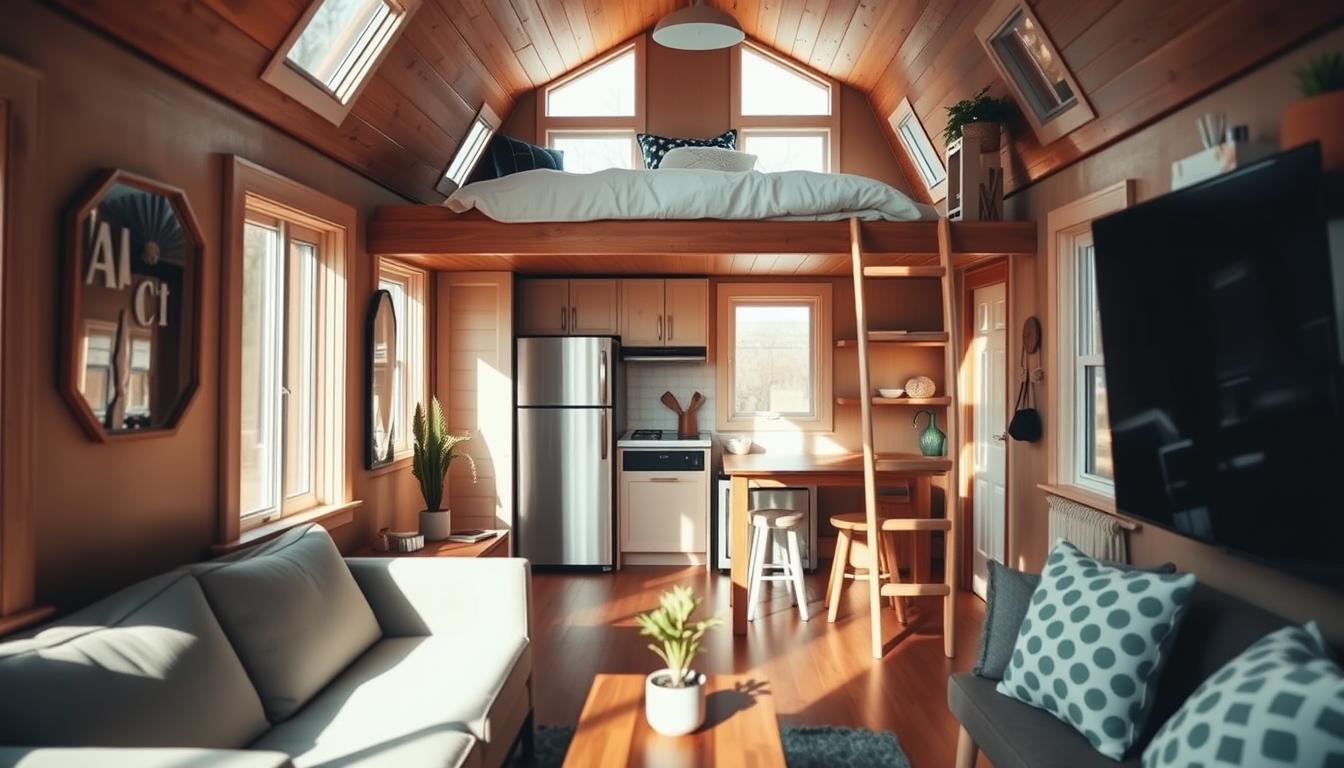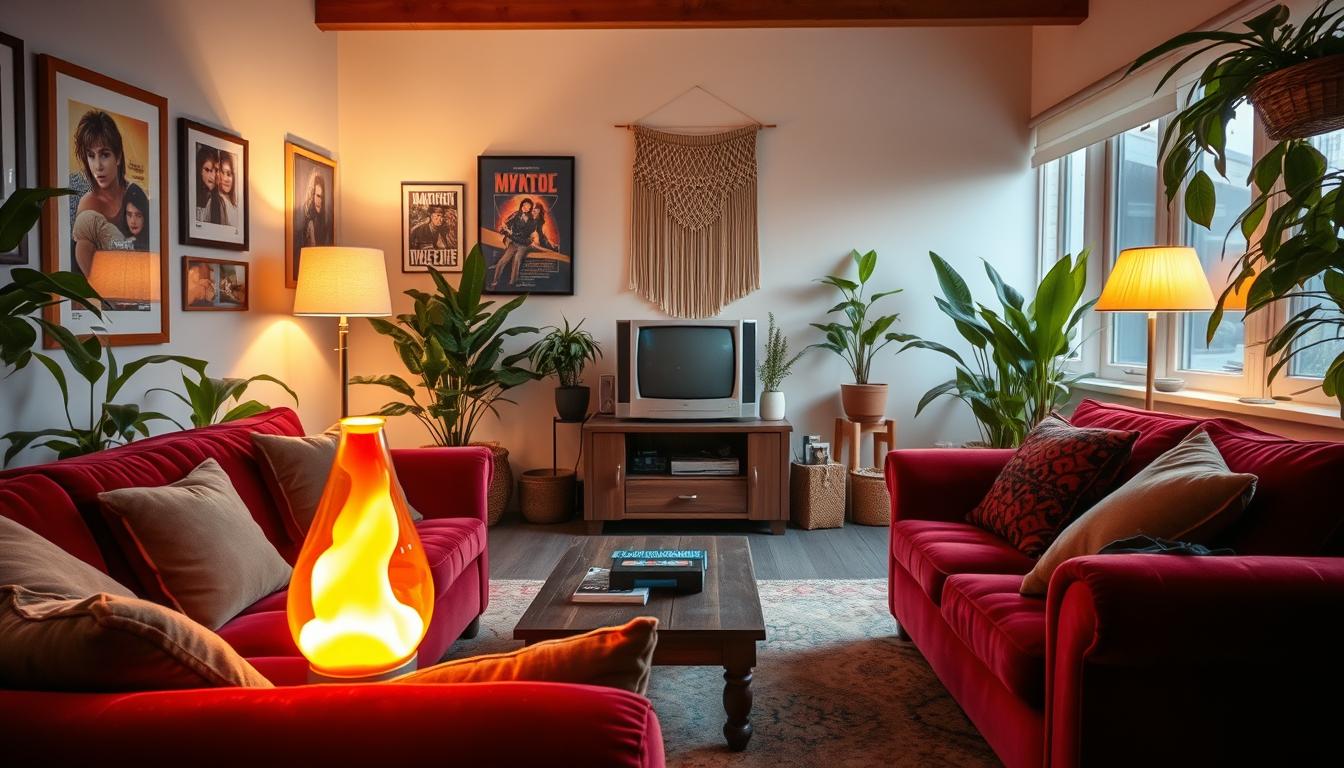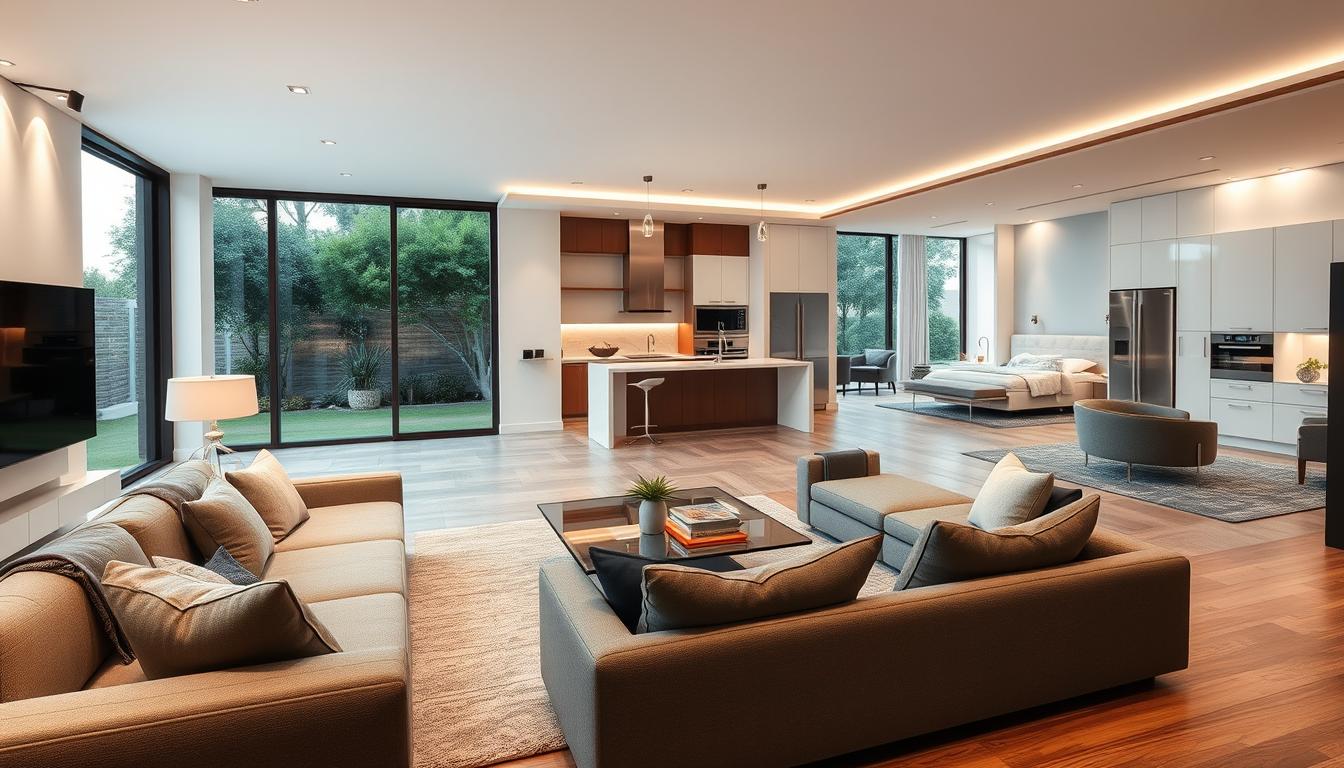Did you know over 10,000 people in the U.S. live in tiny homes? They choose a simpler, more sustainable life. This trend has led to a lot of creativity in small space design. We’ll share practical tips and inspiration to make your tiny home cozy and functional.
We’ll look at the latest trends and ideas for small spaces. You’ll learn how to make the most of your tiny home’s space. We’ll cover clever storage, multi-functional furniture, and more to help you create a beautiful, efficient small space design.
Key Takeaways
- Maximizing storage in small spaces
- Utilizing multi-functional furniture
- Creating a cozy atmosphere with lighting
- Selecting the right color palette for small spaces
- Incorporating natural elements into your design
Maximizing Space in Tiny Homes
Maximizing space in tiny homes is more than just saving square footage. It’s about creating a sense of openness. To do this, you need to use space-saving solutions effectively.
One key strategy is clever storage solutions. Think about hidden compartments, under-bed storage, and wall-mounted shelves. These help keep your belongings organized and your space tidy.
Clever Storage Solutions
Effective storage is key in tiny homes. Look into furniture with built-in storage, like ottomans or storage beds. Also, use vertical space with wall-mounted storage units or shelves. For more ideas, check out our article on tiny home interior ideas.
Some top storage solutions include:
- Hidden compartments behind mirrors or wall art
- Under-bed storage bins or drawers
- Wall-mounted shelves or storage units
Multi-Functional Furniture
Multi-functional furniture is crucial in tiny home design. Items like sofa beds, murphy desks, and nesting tables can do more than one thing. This reduces the need for extra furniture and saves space.
| Furniture | Primary Function | Secondary Function |
|---|---|---|
| Sofa Bed | Seating | Sleeping |
| Murphy Desk | Workspace | Wall Decoration |
| Nesting Tables | Coffee Table | Additional Dining or Workspace |
Vertical Space Utilization
Using vertical space is essential in tiny homes. Wall-mounted shelves, storage units, or hooks help keep floors and surfaces clear. This makes your space feel more open and airy.
- Install wall-mounted shelves or storage units
- Use hooks for hanging items like bikes or accessories
- Opt for floor-to-ceiling curtains or dividers
Color Schemes That Open Up Spaces
In tiny homes, the right colors can really change how open they feel. A smart color scheme can make your tiny home feel bigger and more welcoming.
Light and Airy Palettes
Light and airy colors are perfect for tiny homes. Soft whites, creams, and pale grays make spaces feel bigger. These colors also help light bounce around, avoiding the feeling of being trapped.
To get this look, paint your walls light colors. Use furniture and decor that matches these tones.
Accent Colors for Personality
Even with light colors, bold accents can add your personal touch. Bold and vibrant colors can be used to highlight certain areas.
For instance, a bright rug or a standout piece of furniture can bring in character. Just remember to keep these bold touches balanced with your light colors.
Designing a Cozy Living Area
Creating a cozy living area in a tiny home is all about comfort and style. A well-designed space makes your tiny home a warm and inviting place. It’s where you can relax and feel at home.
Choosing the Right Furniture
Finding the right furniture is key in a tiny home’s living area. Look for pieces that are comfy and do more than one thing. This way, you make the most of your space.
For example, a storage ottoman can be a seat and a place to store things like blankets or books. It shows how micro living design works.
Think about a sofa that turns into a bed for guests, or a coffee table with hidden storage. These items help keep your space tidy. This is important for small space design.
Layering Textures for Warmth
Adding different textures can make your tiny home’s living area feel warmer and more interesting. Start with a plush rug to set the space and add a touchable feel. Then, add throw blankets and pillows in various textures and colors.
Mixing materials like wood, metal, and fabric can also make your space more visually appealing. For instance, a wooden coffee table with metal accents and soft fabric can create a cozy and inviting look. This shows how small space design works, where every detail matters.
By picking the right furniture and layering textures, you can make your tiny home’s living area cozy and welcoming. It will feel spacious and inviting, showing off the best of micro living design.
Smart Kitchen Designs
Smart kitchen designs for tiny homes use space wisely, choose compact appliances, and have efficient layouts. The kitchen is key in any home, and in tiny homes, every inch counts.
Compact Appliances and Layouts
Choosing the right appliances is crucial in a tiny home kitchen. Compact appliances save space without losing functionality. For instance, a compact dishwasher or a microwave-toaster oven combo works well.
For layouts, a galley or L-shaped kitchen is often the best. These designs help in keeping the kitchen tidy and efficient.
Space-Saving Organization Tips
Organizing your kitchen well is as important as the layout. Here are some space-saving organization tips:
- Use pull-out drawers and shelves to maximize storage.
- Install wall-mounted shelves or a pegboard for extra storage.
- Choose a kitchen island for more counter space and storage.
| Organization Tip | Benefit | Implementation |
|---|---|---|
| Pull-out Drawers | Easy access to utensils and ingredients | Install in lower cabinets |
| Wall-Mounted Shelves | More storage for less-used items | Mount on walls, above countertops |
| Kitchen Island | Extra counter space and storage | Place in the center of the kitchen, ensure mobility |
By using these smart kitchen designs and tips, you can make a functional and efficient kitchen in your tiny home.
Multifunctional Bedrooms
In compact living spaces, making a bedroom multifunctional is key. Every inch in tiny homes matters, and the bedroom is no different. It’s not just for sleeping; it’s a space for many uses, making the home more livable.
Murphy Beds and Lofted Options
Murphy beds and lofted sleeping areas save floor space. A Murphy bed folds up against the wall, freeing up space for a desk or living area. Lofted beds have a sleeping area above and space for a desk or storage below.
These options not only save space but also add function to the bedroom. For example, a lofted bed with a desk below can be both a bedroom and an office.
Utilizing Under-Bed Storage
Using under-bed storage is another smart way to use bedroom space. Bed risers can lift the bed, creating space for storage bins or drawers. This is great for storing linens, out-of-season clothes, or personal items.
Under-bed storage solutions keep the bedroom tidy and organized. They make the most of available space. By using these solutions, tiny home residents can enjoy a more spacious and cozy living area.
By using these strategies, tiny home owners can create cozy and functional bedrooms. This makes living in a tiny home more comfortable and efficient.
Creative Bathroom Solutions
Tiny home bathrooms are a unique challenge. But with the right design, they can be both functional and comfortable. It’s key to think about both form and function when designing a tiny home bathroom.
Adopting a minimalist living approach is crucial for an efficient bathroom. Simplifying the layout and reducing clutter makes the space feel larger. For more ideas on making small spaces look great, check out our article on transforming your holiday home with chic interior.
Tiny Bathroom Layout Ideas
In tiny bathrooms, every inch matters. Using a wall-mounted sink and toilet saves floor space. This makes the bathroom feel more open and easier to clean.
Using a shower stall instead of a bathtub is another smart move. If space allows, consider a combination of both. A corner shower is a great way to save space.
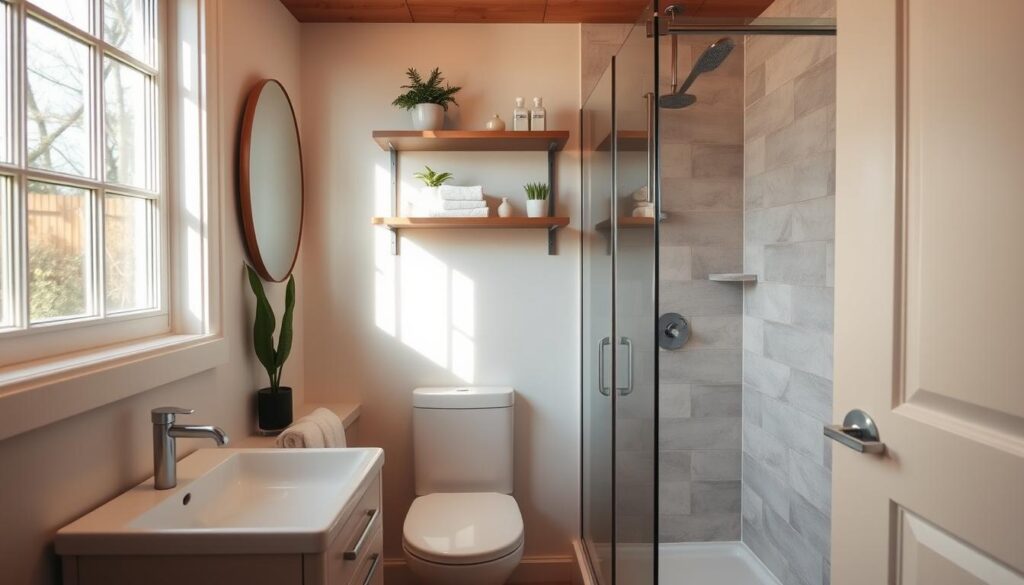
Efficient Fixtures for Small Spaces
Efficient fixtures are key for small space design. Look for toilets and sinks made for small bathrooms. These are often wall-mounted or compact, saving floor space.
Using mirrors and reflective surfaces also helps make a small bathroom feel bigger. Good lighting is important for this effect too.
By using these creative solutions, you can have a functional and comfortable bathroom, even in the smallest of spaces.
Incorporating Nature Indoors
To make your tiny home feel bigger and more connected to nature, think about adding indoor plants and using natural light. This not only makes your home look better but also makes it healthier.
Indoor Plants for Tiny Homes
Indoor plants bring nature into your tiny house. They clean the air, add beauty, and can lower stress. Choose easy-to-care-for plants like succulents or air plants for your indoor space.
Some top picks for tiny home plants include:
- Snake plants, known for their air-purifying properties
- Pothos, which can grow in a variety of lighting conditions
- Peace lilies, offering elegant white blooms and air-purifying benefits
Use vertical space or hanging planters to save floor space when adding plants to your tiny home.
Natural Light: Windows and Skylights
Getting more natural light is key in tiny homes. It makes your home feel bigger and cuts down on the need for artificial lights. Use windows and skylights wisely to let in more light.
For example, a skylight above a staircase can light up dark areas. Big windows or sliding glass doors also bring in a lot of natural light.
| Natural Light Enhancement | Benefits |
|---|---|
| Skylights | Brings in natural light from above, illuminating dark areas |
| Larger Windows | Increases natural light, making spaces feel larger |
| Sliding Glass Doors | Connects indoor and outdoor spaces, enhancing natural light |
By adding indoor plants and using natural light, your tiny home will feel bigger, welcoming, and connected to nature. These steps are crucial for a successful tiny home design, improving both looks and function.
Personalizing Tiny Home Decor
Tiny homes are a chance to make a space truly yours. By adding elements that show your personality, you can make a small area feel welcoming and cozy.
DIY Projects and Self-Made Decor
Doing DIY projects is a fantastic way to make your tiny home special. Try making your own decor, like macrame wall hangings or throw pillows, to add a personal touch.
Some ideas for DIY projects include:
- Upcycling old furniture to give it a new life
- Creating a gallery wall with personal photos and mementos
- Making your own lighting fixtures using natural materials
These projects not only make your home unique but also give you a sense of pride.
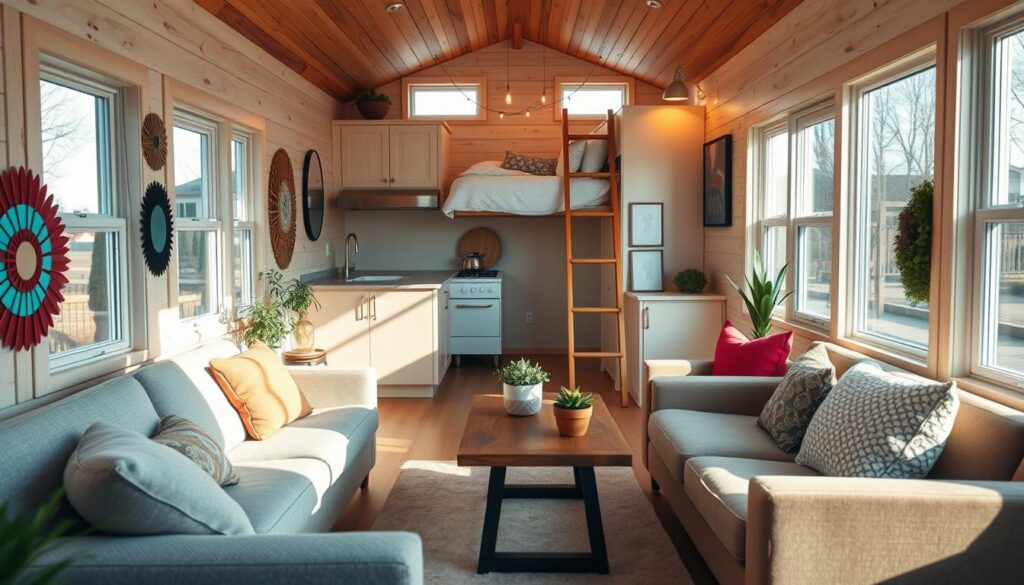
Choosing Meaningful Artwork
Artwork can really change the feel of your tiny home. Pick pieces that mean something to you, like art from local artists or that shows your style.
Consider the following when choosing artwork:
- Opt for pieces that evoke positive emotions
- Select artwork that complements your color scheme
- Don’t be afraid to mix different styles and textures
By carefully choosing your artwork, you can make a space that feels like home.
Sustainable Interior Choices
Sustainable living is key in the tiny home movement. It begins with the choices we make inside our homes. Tiny home owners look for ways to lessen their environmental impact without losing comfort or style.
Using eco-friendly materials is a big step towards sustainability in tiny homes. These materials help reduce environmental harm and make our homes healthier.
Eco-Friendly Materials
Choosing the right materials for your tiny home’s interior is crucial. Reclaimed wood is a favorite for flooring and furniture because it’s unique and reduces waste. Other good options include bamboo, cork, and paints with low-VOCs.
| Material | Eco-Friendly Features | Uses in Tiny Homes |
|---|---|---|
| Reclaimed Wood | Reduces waste, unique aesthetic | Flooring, Furniture, Wall Decor |
| Bamboo | Fast-growing, sustainable | Flooring, Furniture |
| Low-VOC Paints | Improves indoor air quality | Walls, Ceilings |
As
“Sustainability is no longer a trend, but a necessity in modern living.”
, tiny homes lead the way.
Energy-Efficient Designs
Energy efficiency is vital in tiny home interiors. It’s not just about the materials but also the design and layout. For instance, using natural light can cut down on the need for artificial lighting.
By using energy-efficient designs and eco-friendly materials, tiny home owners can make spaces that are good for the planet and save money over time.
Outdoor Spaces That Enhance Tiny Living
Even with limited space, outdoor areas can greatly enhance your tiny living experience. By making the most of your outdoor space, you can expand your living area and enjoy the fresh air. Effective small space design and micro living design often involve utilizing outdoor spaces to create a seamless transition between indoors and outdoors.
Utilizing Balconies and Patios
Balconies and patios are perfect for creating functional outdoor areas. Adding a small patio with a built-in bench can be a great way to create a cozy outdoor seating area. You can also incorporate plants, outdoor lighting, and comfortable furniture to make the most of your outdoor space.
Creating Functional Outdoor Areas
To create functional outdoor areas, consider the purpose of the space. Do you want to use it for relaxing, entertaining, or dining? Once you determine the purpose, you can design the space according to your needs. Incorporating outdoor spaces into your tiny home design can greatly enhance your overall living experience.

